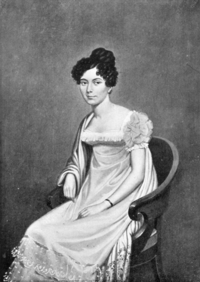Juana María de los Dolores de León Smith
Juana María de los Dolores de León Smith, Lady Smith (27 March 1798 - 12 October 1872) was the wife of General Sir Harry Smith, Governor of the Cape Colony.

Born into an old Spanish noble family, she was a great-granddaughter of Juan Ponce de León.
In 1812, at the age of fourteen, she found herself orphaned and only with a sister, when her home town Badajoz was besieged for the fourth time during the Peninsular War. After the siege ended in a successful but very bloody storming by the British and Portuguese forces, the sisters sought protection from the plundering and pillaging soldiers by some British officers they found camping outside the city walls. One of them was Brigade-Major Harry Smith, of the elite 95th Rifles scout regiment, whom she married a few days later.
Instead of letting herself be sent home to her husband's family, she choose to accompany him with the army. She remained with him throughout the rest of the war, accompanying the baggage train, sleeping in the open on the field of battle, riding freely among the troops, and sharing all the privations of campaigning. Her beauty, courage, sound judgment and amiable character endeared her to the officers, including the Duke of Wellington, who spoke of her familiarly as Juanita; and she was idolized by the soldiers.
With the exception of his stint in the British-American War of 1812 she accompanied her husband in all his deployments, most notably in two postings in South Africa, where Sir Harry (he had been knighted in the meantime) served as Governor of Cape Colony and High Commissioner.
Juana Smith was given a pension of £500 by Parliament on 5 December 1848 in recognition of her husband's services to the country. The pair were always hopeless with money and he fought to get her a pension in his final years.
Known as Lady Smith in her later years, Juana Smith is commemorated directly in the name of Ladysmith, KwaZulu-Natal, South Africa and Ladismith, Western Cape, South-Africa, as well as indirectly in the name of Ladysmith, British Columbia, Canada.
Lady Smith is sometimes said to have introduced the canteloupe or musk-melon (Cucumis melo cantalupensis) to South Africa, where it is known as spanspek (or spanspec or sponspe(c)k), which in Afrikaans literally means Spanish bacon (spans spek). However, the Oxford English Dictionary shows that the term Spanish bacon had been in use since at least the eighteenth century.
Representations in Fiction
Juanita Smith and her husband are the central characters in the novel The Spanish Bride by Georgette Heyer, which spans the period from just before their meeting after the battle of Badajoz through the aftermath of the battle of Waterloo in the latter part of the Napoleonic Wars.
References
- Harry Smith, "Autobiography", J. Murray, London, 1901
- Sir John Kincaid, "Adventures in the rifle brigade in the Peninsula, France and the Netherlands from 1809-1815", London 1830
- Joseph H Lehmann, "Remember you are an Englishman": A Biography of Sir Harry Smith, 1787 - 1860, Jonathan Cape, London, 1977.
- Georgette Heyer, "The Spanish Bride", Heinemann, London, 1940
- Information on the pension via "The Scotsman" archives
External links
- Harry Smith, Autobiography, from the University of Pennsylvania Digital Library Project, (the online edition is directly dedicated to Juana De Leon Smith)
